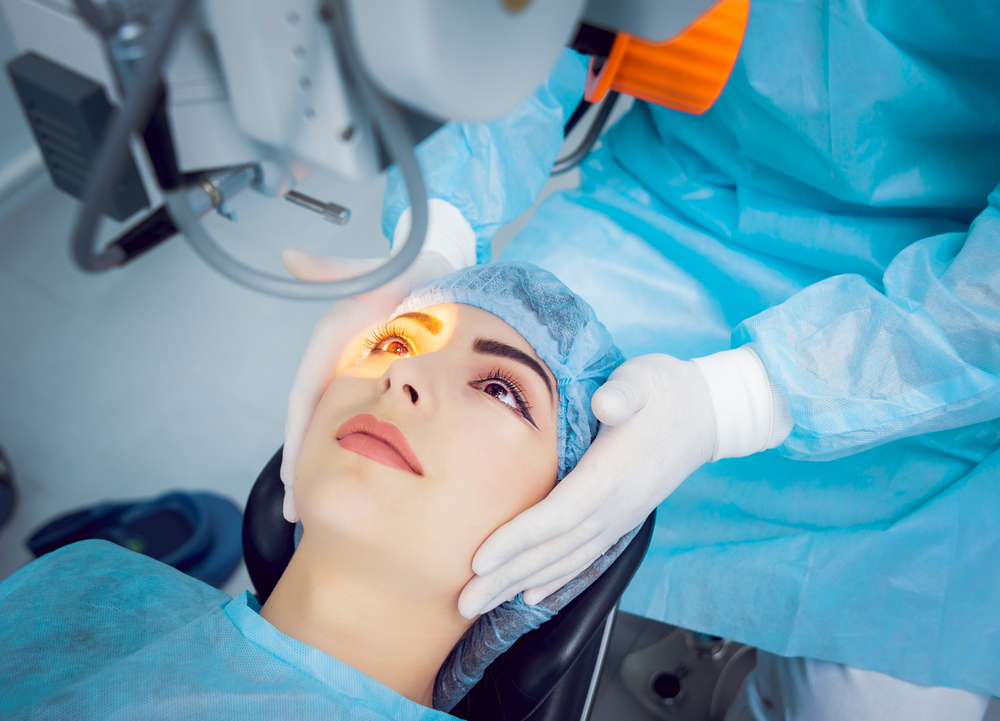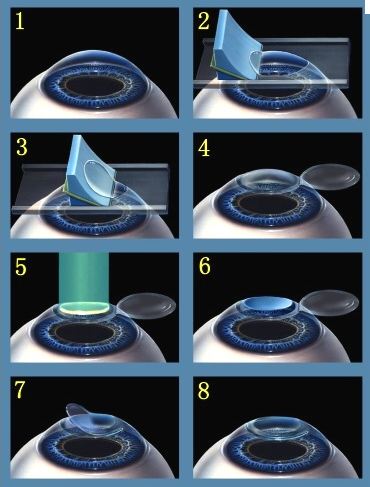
Plantation Eye Associates Laser Vision Correction procedure:
The LASIK Procedure:
LASIK is the most commonly performed refractive surgery procedure and is short for “laser-assisted in situ keratomileusis.”
Why is it so popular?
LASIK has advantages over other vision correction procedures, including a relative lack of pain afterward and the fact that good vision usually is achieved by the very next day. Now a “bladeless” procedure, laser technology is utilized to initially create a thin, circular flap on the corneal surface.
The surgeon folds the hinged flap back out of the way, then removes some corneal tissue underneath using an excimer laser. The excimer laser uses a cool ultraviolet light beam to precisely remove (“ablate”) very tiny bits of tissue from the cornea to reshape it. When the cornea is reshaped for each individuals’ unique refractive error, it will then better focus light into the eye and onto the retina, providing clearer vision than before. The flap is then laid back in place, covering the area where the corneal tissue was removed. Both nearsighted and farsighted people can benefit from the LASIK procedure. With nearsighted people, the goal is to flatten the too-steep cornea; with farsighted people, a steeper cornea is desired. Excimer lasers also can correct astigmatism by smoothing an irregular cornea into a more normal shape.
Before the LASIK Procedure:
To decide whether you’re a good candidate for LASIK, your we will perform an eye exam to determine if your eyes are healthy enough for the procedure, what kind of vision correction you need and how much laser ablation is required.
We will also look for signs of dry eye disease, which must be treated and cleared up before LASIK can be performed. Additionally, a corneal topographer will be used; this device measures the curvature of your eye and creates a kind of “map” of your cornea.
Finally, the we will ask you about any health problems you have or medications you take. Some health conditions will disqualify you altogether for LASIK, but others may just postpone the procedure until a later date.

During LASIK Surgery:
LASIK is an ambulatory procedure — you walk into the surgery center, have the procedure and walk out again. In fact, the actual surgery usually takes less than five minutes, and you’re awake the whole time. If needed a mild oral sedative will be administered beforehand.
Even though the surgery is relatively quick, LASIK is a very delicate procedure and it’s important to have it performed by a highly skilled surgeon with proper equipment. You also should have someone accompany you to the surgery center and drive you home afterward.
Before your LASIK begins, numbing eye drops will be applied to your eyes so you don’t feel any discomfort during the procedure. Then, while lying down, your eye is positioned directly under the laser. (One eye is operated on at a time.) A kind of retainer is placed under your eyelids to keep them open — normally, this is not uncomfortable. An ink marker is used to mark the cornea before the flap is created. The flap is then created with a femtosecond laser that is securely fitted to your cornea with a suction ring to prevent eye movements or loss of contact that could affect flap quality. During the procedure you won’t actually see the creation of the flap, which is very thin. You will be asked to look at a target light for a short time while the surgeon watches your eye through a microscope as the laser sends pulses of light to your cornea.
The laser light painlessly reshapes the cornea. You’ll hear a steady clicking sound while the laser is operating. The higher your prescription, the more time the surgery will take, but is typically less than one minute. The surgeon has full control of the laser and can turn it off at any time. After the procedure is finished, you will rest for a little while. If you’re having both eyes done the same day, the surgeon typically will begin working on your second eye immediately after treatment of the first eye is finished. Your surgeon may prescribe medication for any postoperative pain, but many people feel no more than mild discomfort after LASIK. Eyedrops are then used for several days to help in the healing of the eyes.
After LASIK: Short-Term
As with any kind of surgery, it’s important that you follow your doctor’s instructions to the letter. Get proper rest, use all prescribed medications as directed and call your doctor immediately if you suspect a problem. Immediately after LASIK, the doctor will have you rest for a bit, then you can go home (someone else must drive). At home, you should relax for at least a few hours. You may be able to go to work the next day, but many doctors advise a couple of days of rest instead. They also recommend no strenuous exercise for up to a week, since this can traumatize the eye and affect healing. Avoid rubbing your eye, as there is a chance (though slim) of dislodging the corneal flap.
After LASIK:
With LASIK surgery, most people’s vision improves right away, but some find that their vision gradually improves even more over the next few days or even weeks. LASIK outcomes may vary. Most people achieve 20/20 or better vision with LASIK. Some patients still need glasses or contact lenses following laser vision correction, though their prescription level typically will be much lower than before. Postoperative LASIK complications can include infection or night glare (starbursts or halos that are most noticeable when you’re viewing lights at night, such as while you’re driving).
Rarely, an individual may experience clear vision after LASIK, but then notice a gradual blurring of their eyesight over time (called “regression”). If this happens, discuss it with your surgeon to determine if more surgery (referred to as an enhancement or “touch-up”) will be necessary. Even if you see perfectly after laser eye surgery, you may still need reading glasses or bifocal contact lenses once you reach your 40s. This is because of a condition called presbyopia, which is a normal, age-related change in reading vision. Your distance vision probably will remain sharp, but seeing up close will be more difficult.

